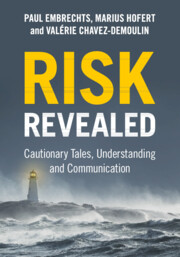Book contents
- Frontmatter
- Dedication
- Contents
- Preface
- Introduction
- 1 The 1953 Great Flood
- 2 The Space Shuttle Challenger Disaster
- 3 The 2007–2008 Financial Crisis
- 4 Earthquakes and Tsunamis
- 5 The L’Aquila Trial and the Public Communication of Risk
- 6 The Coronavirus Pandemic
- 7 Mathematical Wonderland
- 8 Stochastic Modeling
- 9 The Modeling of Extreme Events
- 10 On Climate Change and Related Risk
- 11 Further Examples from the World of Extremes
- 12 Networks
- 13 The Black Tulip and February 3, 1637
- A Note About the References
- References
- Index
Introduction
Published online by Cambridge University Press: 05 April 2024
- Frontmatter
- Dedication
- Contents
- Preface
- Introduction
- 1 The 1953 Great Flood
- 2 The Space Shuttle Challenger Disaster
- 3 The 2007–2008 Financial Crisis
- 4 Earthquakes and Tsunamis
- 5 The L’Aquila Trial and the Public Communication of Risk
- 6 The Coronavirus Pandemic
- 7 Mathematical Wonderland
- 8 Stochastic Modeling
- 9 The Modeling of Extreme Events
- 10 On Climate Change and Related Risk
- 11 Further Examples from the World of Extremes
- 12 Networks
- 13 The Black Tulip and February 3, 1637
- A Note About the References
- References
- Index
Summary
This books reveals aspects of risk on a combined walk/hike/stroll through the landscape of risk. In the walk, we meet several cautionary tales and present historical events from a variety of areas including floods, technological disasters, earthquakes, tsunamis, finance as well as pandemics. From this walk we transition, via a chapter on stories from the realm of mathematics, into a more technically demanding hike. After an introduction of some of the main techniques from probability and statistics, needed to revisit and better understand the cautionary tales, we finish with a stroll discussing several examples where these techniques are applied. A better understanding is achieved by introducting many pedagogical and historical examples. Throughout the book, we stress the need for evidence-based communication. An overall common thread of the book is “From if to what if”. The "what if" thinking links up with the modeling of extreme events and the necessity of stress testing. Throughout, obtaining and analyzing data are key. A special feature of the book is the inclusion of several cartoons by Enrico Chavez. They typically bring arguments made in the text to their key essentials.
Information
- Type
- Chapter
- Information
- Risk RevealedCautionary Tales, Understanding and Communication, pp. xiii - xxPublisher: Cambridge University PressPrint publication year: 2024
